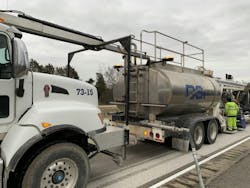By Kristin Dispenza, Contributing Author
Data-driven pavement management has been a focus for departments of transportation (DOTs) since the enactment of “Moving Ahead for Progress in the 21st Century,” or MAP 21, in 2012.
MAP 21 required the development of risk-based Transportation Asset Management Plans (TAMPs). With the support of the Federal Highway Association’s (FHWA) Office of Asset Management, best practices were outlined in such a way that short- and long-term resource allocation decisions could be based on data incorporating engineering, life-cycle cost and risk considerations.
Furthermore, MAP 21 dictated that no more than 5% of a state's interstate pavement be in poor condition. States not achieving that threshold are required to spend a specified percentage of their federal funding to improve those conditions.
“Arkansas, like many states, used to fix our pavements using a ‘worst-first’ approach,” said Sarah Tamayo, State Pavement and Asset Engineer - Maintenance, Arkansas Department of Transportation (ARDOT). “About 14 years ago, I was introduced to pavement preservation at a conference I attended on preservation for asphalt and concrete pavements. Around the same time, ARDOT began the shift to a data-driven approach.
“Now, more than 10 years in, we are seeing our pavements last longer because we are keeping good roads in good shape.”
Asset Management in Arkansas
ARDOT uses an Automatic Road Analyzer (ARAN) vehicle to assess interstate conditions, along with boots-on-the-ground inspections.
ARDOT also regularly incorporates newer technologies, such as its 2017 adoption of three-dimensional imaging for pavement cracking, which improves crack detection. Data on interstates is collected each year. (System-wide, data is collected on one-half of highways in a given year, with the remaining half collected the following year.)
Once data collection is complete, it is processed and a pavement condition index (PCI) summary is calculated for each one-tenth-mile-long pavement section using an average of four types of pavement metrics: environmental cracking, structural cracking, roughness and rutting.
The PCI is then used to categorize the pavement into a five-point rating scale (very good, good, fair, mediocre and poor). These ratings are used to help develop pavement preservation projects.
Conditions are also assessed using FHWA threshold criteria for each one-tenth-mile-long pavement section. The index is then used to assign a pavement condition rating, or “grade,” which describes the pavement condition of the state highway system as good, fair or poor. This grade is only used for the federal reporting process.
Rideability at a Competitive Cost
Ten to 15% of the pavement on Interstate-40 in Arkansas is constructed of concrete, and two adjacent sections of concrete pavement in Johnson County serve as a testimonial to the advantages of pavement preservation.
The two sections, which total just over 10 miles in length, see an average daily traffic (ADT) of 28,000 vehicles per day, with 36% of that traffic being trucks.
The first stretch of pavement, with a length of 4.3 miles, was constructed in 2002 using a 4-inch stone base, 4-inch treated permeable base and 12-inch jointed concrete pavement.
The outside lane was 14-feet-wide with an 8-foot asphalt shoulder. The cost of the 12-inch concrete pavement was $24.15 per square yard in 2002 dollars; the total cost of the project was $9.4 million.
At the time of construction, the pavement had an average international roughness index (IRI) of approximately 95-inches per mile. Pavement preservation was triggered in 2019 when an IRI of 112 was measured since ARDOT’s goal is to keep IRI measurements close to 95.
No maintenance has been performed on the pavement since it was built; the only maintenance activities have been periodic asphalt shoulder patching and cleaning of edge drains.
In 2019, ARDOT developed plans and let a concrete pavement preservation (CPP) project in 2020. Diamond Surface of Rogers, Minnesota was awarded the contract. The existing pavement was in excellent structural condition with few cracked slabs, so CPP consisted of patching 138 square yards—or 0.1% of the area—along with diamond grinding for smoothness and joint rehabilitation.
The project was ground to an average IRI of 43 inches per mile. The cost for diamond grinding was $825,000 and the cost for joint resealing was approximately $300,000. The total cost for the project was $1.125 million, or $65,400 per lane mile. The reduction in IRI shows a 10-year savings of about $2 million or 7,100 metric tons of carbon when evaluated with the IGGA MIT cost/carbon IRI calculator.
The second stretch of pavement adjoins the first and was built three years after it in 2005. With a length of 6.1 miles, it has the same construction as the first section, with the exception of the jointed concrete pavement having a thickness of 13 inches as compared to 12 inches. The cost of the 13-inch concrete pavement was $33.48 per square yard in 2005 dollars and, excluding bridgework, the total project cost was $16.9 million.
Over the years, the second stretch of pavement received the same minimal maintenance as the first: asphalt shoulder patching and edge drain cleaning.
The 2005 pavement was constructed with an average IRI of approximately 72 inches per mile and, as with the first stretch, IRI measurements were repeated regularly as part of the state’s TAMP. Even after almost 15 years of service, the smoothness of the pavement stayed about the same.
“The 2005 project has the same average daily traffic, the same cross-section, and the same soil conditions as the project performed in 2002, yet whereas the first stretch of pavement saw a minor increase in IRI from 100 to 112 in 17 years of service, the second stretch saw a five-point increase,” said Alan Meadors, former Arkansas Promotional Director, Oklahoma/Arkansas Chapter, American Concrete Pavement Association (ACPA). “One hypothesis is that the additional one inch of concrete pavement may have helped the concrete maintain its original condition.”
Factoring in Carbon Savings
In addition to improving smoothness and rideability, CPP confers sustainability benefits that build on the inherent sustainability of long-lived concrete pavement.
Two important considerations when it comes to the environmental advantages of pavement are the reduction in carbon associated with fuel savings and the ability of concrete to sequester carbon.
Fuel Savings: While it may seem that the math is simple and car milage is directly related to miles driven, fuel consumption can be impacted by a road’s smoothness conditions. According to MIT’s CSHub, deflection and roughness are two important factors influencing how pavements affect fuel consumption.
Deflection of a road surface creates slight depressions that vehicles have to use additional force to roll out of. Extra fuel is required to exert that force and, over many miles, it adds up.
Pavement roughness causes a similar situation, in which too many points of contact between the tire and the pavement are eliminated. In addition to negatively impacting vehicle control and safety, the uneven contact increases the rolling resistance, and thus the amount of fuel required to overcome the resistance.
In short, vehicles traverse smooth and rigid surfaces more efficiently than flexible or rough surfaces.
Carbonation: Over the life cycle of a concrete road, the potential for carbonation, although small, can be significant depending on the surface area of the pavement.
Carbon emissions occur during the production of portland cement when limestone (consisting of calcium carbonate) is added to the kiln. When brought to a high temperature, the calcium carbonate converts to lime—the product required for portland cement production—and carbon dioxide, which is released into the atmosphere.
However, once the portland cement is hydrated during and after construction, a partial reversal of the process begins.
As the concrete surface is exposed to atmospheric carbon dioxide, the calcium hydroxide and calcium silicate hydrate in the hardened cement paste react chemically with the carbon dioxide, converting back to limestone and recapturing the equivalent of some of the carbon dioxide that was emitted during production. This carbon capture is known as carbonation.
While carbonation slows over a pavement’s lifetime due to pores in the surface becoming blocked, the process can be restarted by diamond grinding and exposing new surface area.
To quantify the carbon savings opportunities associated specifically with maintaining and smoothing the I-40 concrete pavement, ARDOT worked with the International Grooving and Grinding Association (IGGA).
The IGGA, in partnership with the MIT CSHub, has created a fuel/carbon savings calculator. Using inputs such as traffic counts and pre- and post-grind IRI, the calculator evaluates the cost and carbon savings associated with carbonation and reduced fuel usage.
According to the IGGA calculator, carbon savings associated with the CPP performed on the first, 4.3-mile stretch of I-40 in Johnson County (given its ADT of 28,000 vehicles per day, with 36% trucks) was an estimated 7,184 metric tons of carbon dioxide over 10 years.
Carbon associated with fuel savings (achieved by improving IRI) accounted for 7,472 metric tons saved, while carbon sequestration accounted for 39 metric tons. (327 metric tons of carbon dioxide associated with the diamond grinding process was subtracted from the total of 7,472 to arrive at the net carbon savings of 7,184).
In terms of cost savings, $3.4 million will be saved on fuel. Deducting the cost of grinding ($850,000), the total monetary savings is estimated at $2.5 million.
The Data-Driven Approach Pays Off
Based on the positive outcome of the original concrete construction, combined with CPP at the 15- to 18-year point, ARDOT is planning several more upcoming CPP projects, notably two large sections on Interstate-30.
“CPP is working,” said Tamayo.
“This job is a perfect example of how timely preservation activities can restore ride and extend the life of concrete pavements,” said Meadors. RB
Kristin Dispenza is an account manager at Advancing Organizational Excellence.



